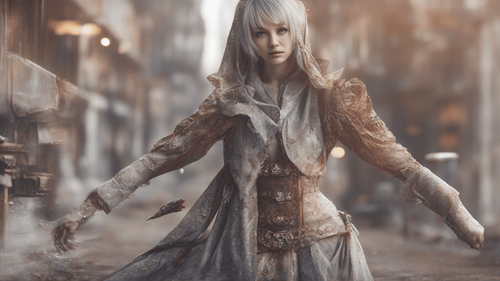
Introduction: Pioneering the Future of Art and Innovation
In the realm of artificial intelligence, one phenomenon has captured both the imagination and practical applications: generated images AI. This revolutionary technology has sparked a new era of creativity and innovation across various industries, from art and design to marketing and gaming. By harnessing the capabilities of AI to produce visually captivating and original images, we are witnessing a transformation that has the potential to reshape the way we perceive art, engage with technology, and even solve complex problems.
Generated Images AI: Crafting Visual Wonders
Understanding Generated Images AI
At its core, generated images AI involves training artificial neural networks to generate images that resemble those found in a given dataset. Through the intricate interplay of algorithms and data patterns, AI models learn to create stunning visuals that range from lifelike photographs to abstract masterpieces. The generated images often possess a unique blend of familiarity and novelty, capturing the essence of human creativity while adding an element of unpredictability.
How Generated Images AI Works
To produce these awe-inspiring images, AI models leverage a technique known as Generative Adversarial Networks (GANs). GANs consist of two neural networks—the generator and the discriminator—locked in a creative duel. The generator crafts images, attempting to fool the discriminator into believing that they are authentic. Simultaneously, the discriminator refines its ability to distinguish real images from generated ones. This back-and-forth process leads to the refinement of the generator's skills over time, culminating in the production of high-quality, generated images.
Applications Across Industries: Where Art and AI Converge
Artistic Exploration and Expression
Generated images AI has breathed new life into the world of art. Artists and designers now have a powerful tool at their disposal, enabling them to explore uncharted territories of creativity. By collaborating with AI, creators can push the boundaries of their own imagination, resulting in artworks that are as captivating as they are innovative. Paintings, sculptures, and digital art pieces that blend human ingenuity with AI's novel perspectives are taking the art world by storm.
Design and Advertising Revolution
The impact of generated images AI in design and advertising cannot be overstated. Marketers can effortlessly generate captivating visuals for campaigns, saving time and resources. Designers, on the other hand, can explore various options quickly, enabling them to experiment with ideas that were previously unattainable. The ability to fine-tune and customize images to align with brand identity has ushered in a new era of precision and creativity.
Entertainment and Gaming Enhancement
The entertainment and gaming industries have embraced generated images AI to create immersive experiences that captivate audiences. Video games now boast environments, characters, and assets that are not only stunning but also procedurally generated. This dynamic approach ensures that each playthrough is a fresh adventure. Additionally, filmmakers are using AI to generate visual effects and settings that were once reserved for the realm of science fiction.
Medical Imaging and Scientific Breakthroughs
Even in the realm of science and medicine, generated images AI has found a crucial role. Researchers and medical professionals leverage AI-generated imagery to visualize complex biological processes and structures. This breakthrough enables them to gain deeper insights into diseases, facilitating earlier diagnoses and more effective treatments. Furthermore, AI-generated simulations aid in predicting the behavior of molecules, contributing to advancements in drug discovery and material science.
FAQs: Demystifying the World of Generated Images AI
What Are the Key Components of Generated Images AI?
Generated images AI relies on Generative Adversarial Networks (GANs), which consist of a generator and a discriminator network. The generator produces images, while the discriminator evaluates their authenticity.
Can AI Truly Replicate Human Creativity?
While AI can simulate human creativity, it does so through learned patterns and data. While impressive, AI-generated art is a fusion of machine learning algorithms and existing art styles, rather than entirely autonomous creativity.
Is Generated Images AI Limited to Visual Art?
No, generated images AI finds applications beyond visual art. It has proven valuable in fields such as medical imaging, scientific simulations, and even enhancing video game environments.
How Can Artists Collaborate with AI?
Artists can collaborate with AI by training AI models on their existing artworks, styles, and preferences. This allows the AI to generate images that align with the artist's vision, serving as a source of inspiration and experimentation.
Are There Ethical Considerations in AI-Generated Art?
Absolutely. The use of AI in art raises questions about authorship, originality, and the role of human creators. Additionally, there's a need to ensure that AI-generated content is not used to deceive or manipulate audiences.
What Does the Future Hold for Generated Images AI?
The future of generated images AI is bright. As technology advances, AI models will likely become more sophisticated, enabling even greater collaboration between humans and machines. This could lead to entirely new art forms and creative possibilities.
Conclusion: A New Horizon of Imagination and Innovation
In the realm of generated images AI, possibilities are boundless. From reshaping traditional art forms to propelling scientific advancements, AI's creative capabilities are transforming industries across the spectrum. As we stand at the intersection of human imagination and machine ingenuity, we witness the birth of a new era—one where AI not only assists us but collaborates with us to push the boundaries of what's possible. The journey has just begun, and the world of art and innovation is poised for a revolution fueled by generated images AI.